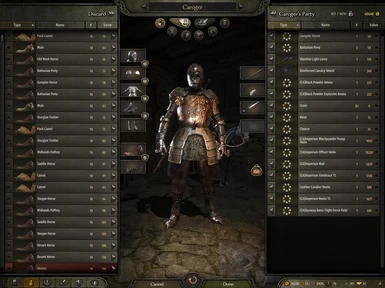Thanks to szszss and her TpacTool, we have access to elements of Bannerlord's asset packages. I thought it might be interesting to share some of our insights in advance of TW publishing their modding tools, documentation and workflow guides. I'll kick off with the following observations:
1. Poly-count vs optimisation
Given larger scale battles and extensive use of LODs, I expected tight budgetary ranges for poly-counts. Umit Singil's Dev blog suggested 8,000-12,000 polys for most armours. So, I was surprised by some extreme differences in poly-count such as these two Vlandian body armours:
 veteran_mercenary_armor, on the left, weighs in at 19,694 polys vs templar_a_red, on the right, at 2,652 polys. In fact, this mercenary armour uses more polys at LOD3 than the templar armour does at LOD0. At LOD5 the mercenary armour still uses 933 polys vs a mere 113 polys for the templar armour.
veteran_mercenary_armor, on the left, weighs in at 19,694 polys vs templar_a_red, on the right, at 2,652 polys. In fact, this mercenary armour uses more polys at LOD3 than the templar armour does at LOD0. At LOD5 the mercenary armour still uses 933 polys vs a mere 113 polys for the templar armour.
Clearly, modders catering only for players with hi-spec pcs can include higher poly meshes than I suspected.
2. Feminization of Armours
In Warband, feminized armours were held in a separate vertex frame. In Bannerlord, each male body armour is accompanied by a feminized version called armourname_converted. Clearly these are automatically generated by some tool as: a) they have identical poly-counts despite differing chest bulges and b) female dresses and armours which don't need to be feminized are still accompanied by an auto-produced and redundant _converted version.
3. Eliminating glove clipping
Every male or converted (feminized) body armour is accompanied by a _slim version. The following shows both versions of Vlandian crossbow_armor with the slim version on the right:
 Only the wrists are slimmed to avoid clipping between armour sleeves and a gauntlet's forearm guards. The next image shows both armours again with crossbow_armor_hand added:
Only the wrists are slimmed to avoid clipping between armour sleeves and a gauntlet's forearm guards. The next image shows both armours again with crossbow_armor_hand added:
 No prizes for guessing, which one's the _slim version. This slimming approach to gloves explains the high break point between the underlying body's hand/wrist component and torso/arm component.:
No prizes for guessing, which one's the _slim version. This slimming approach to gloves explains the high break point between the underlying body's hand/wrist component and torso/arm component.:

4. Scales
vlandia_leather_scale_armour has two components an underlying armour (3,814 polys) and a collection of planes for the scales (2,186 polys) using an alpha material (vlandia_leather_scale_armor_alpha). The following image is only the mesh for the alpha material:

5. Ears
The Bannerlord head has big ears that stick out:
 I had hoped that some clever code flattened them against the skull or removed them (like the flag that removes hair to avoid helmet clipping), allowing slimmer helmets. Unfortunately, it appears that helmet meshes must be wide enough to engulf and hide them:
I had hoped that some clever code flattened them against the skull or removed them (like the flag that removes hair to avoid helmet clipping), allowing slimmer helmets. Unfortunately, it appears that helmet meshes must be wide enough to engulf and hide them:

 This matters little for Bannerlord where helmets all seem to ride above the ears with hair or coifs covering them. However, for later medieval plate helmets this will force a fatter and uglier mesh than I'd hoped. IMO some full conversion modder will need to pin back those ears.
This matters little for Bannerlord where helmets all seem to ride above the ears with hair or coifs covering them. However, for later medieval plate helmets this will force a fatter and uglier mesh than I'd hoped. IMO some full conversion modder will need to pin back those ears.
I'll add more insights as I come across them and would appreciate contributed insights to pool our knowledge.
1. Poly-count vs optimisation
Given larger scale battles and extensive use of LODs, I expected tight budgetary ranges for poly-counts. Umit Singil's Dev blog suggested 8,000-12,000 polys for most armours. So, I was surprised by some extreme differences in poly-count such as these two Vlandian body armours:

Clearly, modders catering only for players with hi-spec pcs can include higher poly meshes than I suspected.
2. Feminization of Armours
In Warband, feminized armours were held in a separate vertex frame. In Bannerlord, each male body armour is accompanied by a feminized version called armourname_converted. Clearly these are automatically generated by some tool as: a) they have identical poly-counts despite differing chest bulges and b) female dresses and armours which don't need to be feminized are still accompanied by an auto-produced and redundant _converted version.
3. Eliminating glove clipping
Every male or converted (feminized) body armour is accompanied by a _slim version. The following shows both versions of Vlandian crossbow_armor with the slim version on the right:



4. Scales
vlandia_leather_scale_armour has two components an underlying armour (3,814 polys) and a collection of planes for the scales (2,186 polys) using an alpha material (vlandia_leather_scale_armor_alpha). The following image is only the mesh for the alpha material:

5. Ears
The Bannerlord head has big ears that stick out:



I'll add more insights as I come across them and would appreciate contributed insights to pool our knowledge.
Last edited:





















